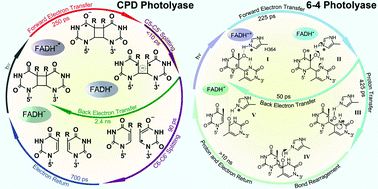Dynamics and mechanisms of DNA repair by photolyase
Abstract
Photolyases, a class of flavoproteins, use blue light to repair two types of ultraviolet-induced DNA damage, a cyclobutane pyrimidine dimer (CPD) and a pyrimidine-pyrimidone (6-4) photoproduct (6-4PP). In this perspective, we review the recent progress in the repair dynamics and mechanisms of both types of DNA restoration by photolyases. We first report the spectroscopic characterization of flavin in various redox states and the active-site solvation dynamics in photolyases. We then systematically summarize the detailed repair dynamics of damaged DNA by photolyases and a biomimetic system through resolving all elementary steps on ultrafast timescales, including multiple intermolecular electron- and proton-transfer reactions and bond-breaking and -making processes. We determined the unique electron tunneling pathways, identified the key functional residues and revealed the molecular origin of high repair efficiency, and thus elucidate the molecular mechanisms and repair photocycles at the most fundamental level. We finally conclude that the active sites of photolyases, unlike the aqueous solution for the biomimetic system, provide a unique electrostatic environment and local flexibility and thus a dedicated synergy for all elementary dynamics to maximize the repair efficiency. This repair photomachine is the first enzyme that the entire functional evolution is completely mapped out in real time.


 Please wait while we load your content...
Please wait while we load your content...